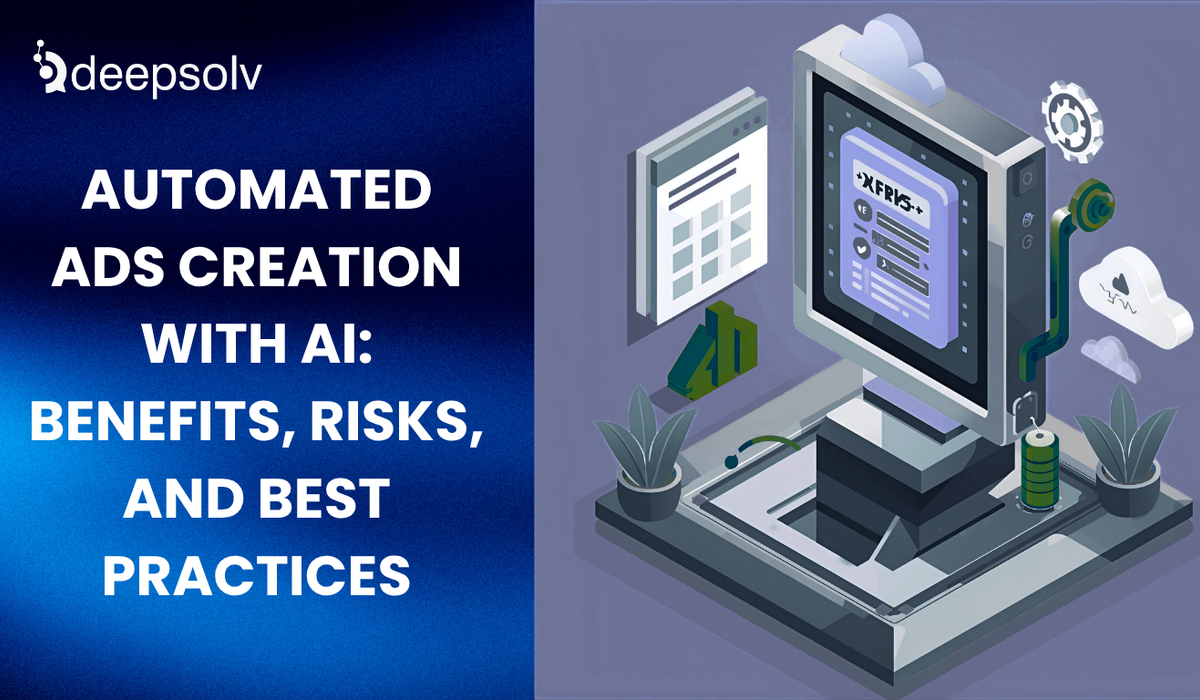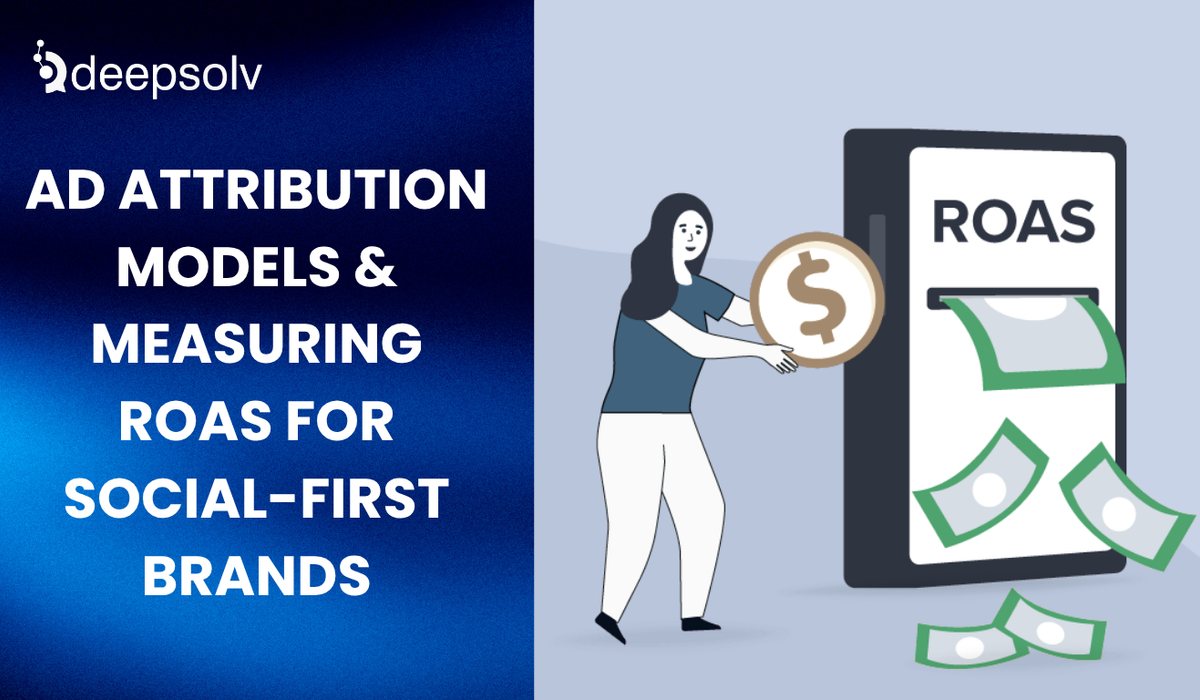Automated Ads Creation with AI: Benefits, Risks, and Best Practices
5 min read
Published: 10/11/2025

Introduction: The New Age of Ad Creation Is Here
In 2025, the world of digital advertising is unrecognizable from even five years ago. Once, marketers spent days crafting ad copy, testing visuals, and optimizing targeting. Now, AI tools can build, test, and personalize entire campaigns in minutes.
Meta’s Advantage+ Creative, Google’s Performance Max, and emerging AI tools like Deepsolv’s Adam are redefining how brands approach ad creation combining automation with creativity at scale.
But with this speed and power come new questions: How do we maintain brand authenticity? Can AI truly understand emotion, tone, and culture? And most importantly when should humans step in?
This blog dives deep into automated ad creation with AI, exploring its benefits, risks, and best practices so your brand can scale smarter and not just faster.
What Is Automated Ad Creation with AI?
Automated ad creation with AI refers to using machine learning tools to generate ad components like headlines, visuals, targeting, and copy and even optimize them in real time based on performance data.
How It Works (Simplified):
- Data Input: AI tools analyze historical campaign data, brand tone, audience insights, and product descriptions.
- Ad Generation: AI creates variations of ad copy, visuals, and CTAs tailored to audience segments.
- Testing & Optimization: The system runs multiple variations, tracks engagement, and promotes the best-performing creatives automatically.
Example: A D2C beauty brand can upload its catalog and customer personas to Adam by Deepsolv. Adam then generates 50+ creative variations from Reels copy to carousel headlines — testing tone, visuals, and CTAs. The brand reviews, edits, and approves top performers, saving weeks of manual A/B testing.
Why AI Is Transforming Ad Creation in 2025
Automation in advertising isn’t new- what’s new is the level of intelligence.
In 2025, AI no longer just automates tasks; it understands audience psychology, sentiment, and context.
Here’s what makes modern AI ad creation different:
- Hyper-personalization: Ads dynamically change based on user data — interests, demographics, or real-time behavior.
- Predictive analysis: AI forecasts which creatives will perform best before launch.
- Cross-platform adaptability: It creates platform-specific assets (Reels vs. Stories vs. YouTube Shorts) automatically.
- Creative collaboration: Human teams guide brand tone and direction; AI handles scale and iteration.
According to a 2025 Gartner report, AI-generated ads now outperform manually created campaigns by 32% on average in click-through rates (CTR) when supervised with proper human review.
The Benefits of Automated Ad Creation with AI
Let’s break down the major advantages:
1. Speed and Scalability
AI can produce in hours what human teams take weeks to develop.
Example: A global e-commerce brand like Nike tests hundreds of ad creatives across geographies and languages. Using AI-driven automation, Nike can deploy local-language versions of global campaigns overnight — cutting creative time by 80%.
For small and mid-sized brands, this means access to enterprise-level speed without needing massive teams.
2. Data-Driven Creativity
AI doesn’t guess — it learns. It analyzes millions of data points (clicks, dwell time, conversions) to generate ad elements that statistically perform better.
So instead of creating “what feels right,” marketers can build ads informed by behavioral data.
Example: Deepsolv’s Adam studies audience tone, sentiment, and past engagement, then tailors ad copy that resonates whether you’re targeting first-time shoppers or loyal customers.
3. Continuous Optimization
AI tools don’t just create ads; they also monitor and improve them in real time.
If one creative underperforms, the algorithm reallocates budget to higher-performing variations instantly, no waiting for a human analyst to notice trends.
Benefit: Always-on optimization means brands can maintain high ROI even when creative teams are offline.
4. Cost Efficiency
By automating repetitive creative and testing workflows, AI reduces dependency on large design or copywriting teams. Instead, human creatives can focus on storytelling, strategy, and emotional resonance.
Over time, this hybrid model — human direction + AI execution lowers costs while maintaining quality.
5. Improved Consistency Across Platforms
AI ensures brand tone and message remain consistent across multiple channels — Meta, Google, TikTok, LinkedIn even while adapting the format for each.
No more fragmented ad messaging or mismatched visuals.
The Hidden Risks of AI-Powered Ad Creation
Like every powerful tool, AI comes with trade-offs. Let’s explore the major risks and how to avoid them.
1. Loss of Brand Voice
AI learns from data and not from emotion. Without proper oversight, ads can sound generic or off-brand.
Example: A luxury brand using unsupervised AI might generate overly casual copy like “Grab yours now!” eroding premium perception.
Solution: Always “train” your AI on brand tone — upload past copy, guidelines, and style references. Deepsolv’s Adam does this automatically through contextual learning.
2. Creative Homogenization
When everyone uses similar AI tools, ads start to look alike. Feed fatigue sets in quickly when users see the same type of “AI-optimized” creative across brands.
Solution: Maintain human creative direction. Use AI for scale and testing, not originality. Humans should decide the narrative; AI should amplify it.
3. Ethical & Privacy Concerns
AI-driven targeting relies on large amounts of data. Misuse or over-personalization can lead to privacy violations or ethical backlash.
Example: An ad that “predicts” user behavior too accurately can feel invasive — lowering trust and brand favorability.
Solution: Follow GDPR and Meta’s Responsible AI guidelines. Limit personalization to contextual relevance rather than personal data profiling.
4. Over-Reliance on Automation
When teams trust AI blindly, they lose the nuance that makes marketing human. Algorithms can misinterpret sarcasm, humor, or cultural nuance — leading to tone-deaf ads.
Solution: Maintain a “Human in the Loop” system — every AI output must be reviewed before going live.
Best Practices for AI-Driven Ad Creation
1. Define Brand Parameters First
Train your AI on brand tone, style, audience personas, and existing high-performing creatives. Use this as your creative “sandbox” before scaling.
2. Mix Human Strategy with AI Scale
AI is powerful at creating and testing, but only humans understand cultural context. Use AI to handle volume, while human teams focus on direction and storytelling.
3. Use Real-Time Performance Feedback
Monitor CTR, ROAS, and engagement metrics weekly. Adjust your creative strategy based on AI insights — not assumptions.
Example: If carousel ads outperform videos by 25%, prompt your AI to generate more carousel variations and test headlines around emotional triggers.
4. Diversify Creative Formats
Avoid creative fatigue by generating multiple ad types:
- Short-form video (for TikTok & Reels)
- Static image (for remarketing)
- Conversational copy (for Meta Messenger ads)
AI can quickly produce variations across formats without compromising tone.
5. Prioritize Transparency and Privacy
Always disclose if your brand uses AI in creative testing or personalization — it builds consumer trust. Work only with tools that comply with privacy regulations and offer first-party data integrations.
6. Test, Learn, Iterate
AI thrives on feedback. The more data you feed it (good or bad), the smarter it becomes. Create a feedback loop between performance results and creative generation — like Deepsolv’s Adam, which evolves its tone and creative logic based on your campaign insights.
Real-World Brand Examples
1. Coca-Cola’s “Create Real Magic” Campaign
In 2025, Coca-Cola used AI tools like GPT and DALL·E to allow fans to co-create branded visuals. The campaign generated 120,000+ user submissions and 1.5 billion impressions — proving how AI can blend automation with human imagination.
2. Glossier’s Meta Creative Optimization
Glossier used Meta’s Advantage+ creative automation to dynamically adjust ad headlines, visuals, and CTA buttons. CTR improved by 27%, and cost-per-acquisition (CPA) dropped by 18% within two months.
3. Deepsolv Client Example:
A sustainable fashion D2C brand used Adam to automate ad copy creation across Meta and TikTok.
- 70% reduction in creative production time
- 33% higher CTR vs manually written copy
- 2.8x improvement in blended ROAS over 45 days
Adam analyzed engagement sentiment and rephrased CTAs to align better with eco-conscious buyer psychology — an impossible task for static templates.
The Future of AI in Ad Creation
By 2026, over 80% of paid ads will involve some form of AI-generated component, according to eMarketer. But the biggest winners won’t be the brands that automate everything — they’ll be the ones that combine AI’s efficiency with human empathy.
AI can analyze, predict, and optimize — but it still can’t feel. That’s where your creative team comes in: to tell stories, define emotion, and give meaning to data-driven advertising.
Conclusion: Automate Intelligently, Not Blindly
AI isn’t replacing creative marketers — it’s redefining their role. Instead of writing one ad at a time, you’ll guide hundreds of automated variations. Instead of manually testing every element, you’ll focus on the why behind performance.
The key is balance. Use AI for what it does best — scaling, testing, optimizing — and let humans handle what machines can’t: emotion, context, and connection.
⚡ Ready to See What AI Can Create for You?
👉 Book your free strategy call with Deepsolv. We’ll show you how Adam can automate ad creation, predict top-performing creatives, and help you scale campaigns 3x faster — without losing your brand voice.
⏳ Limited free consultations left this month — secure your spot now.
FAQs
Frequently asked questions related to this blog post


